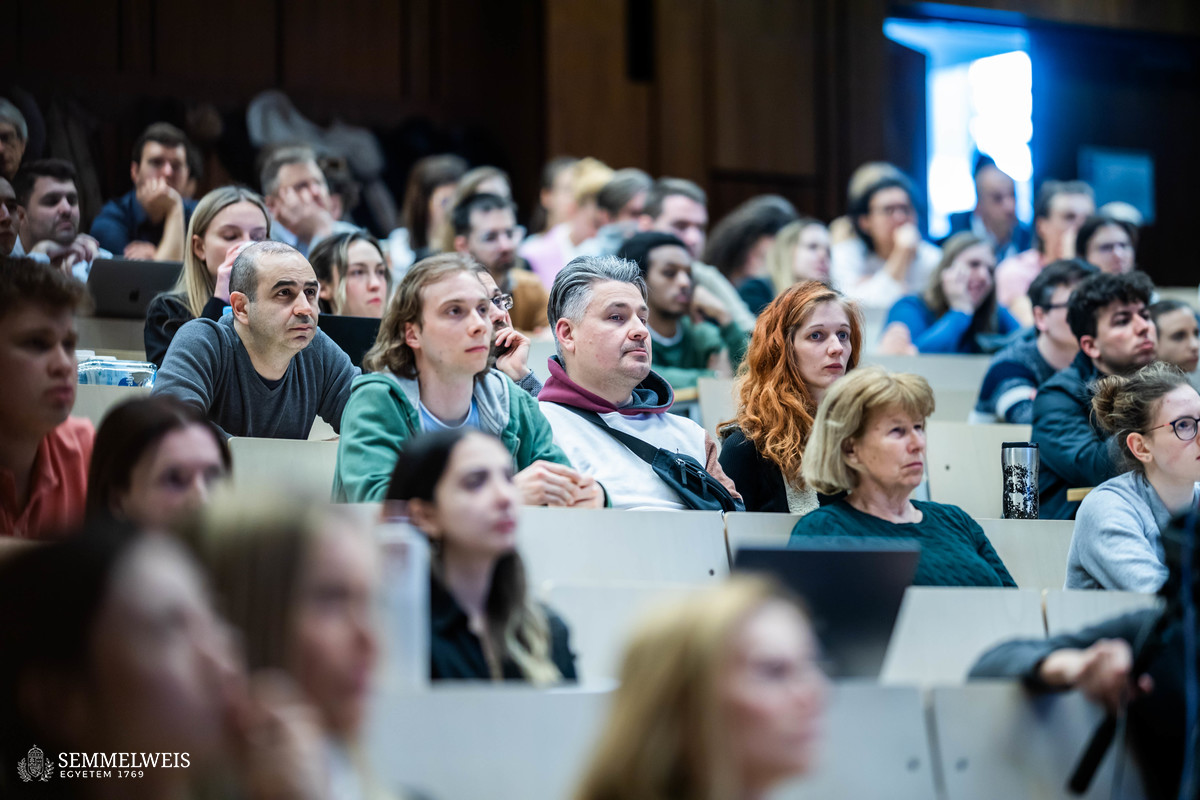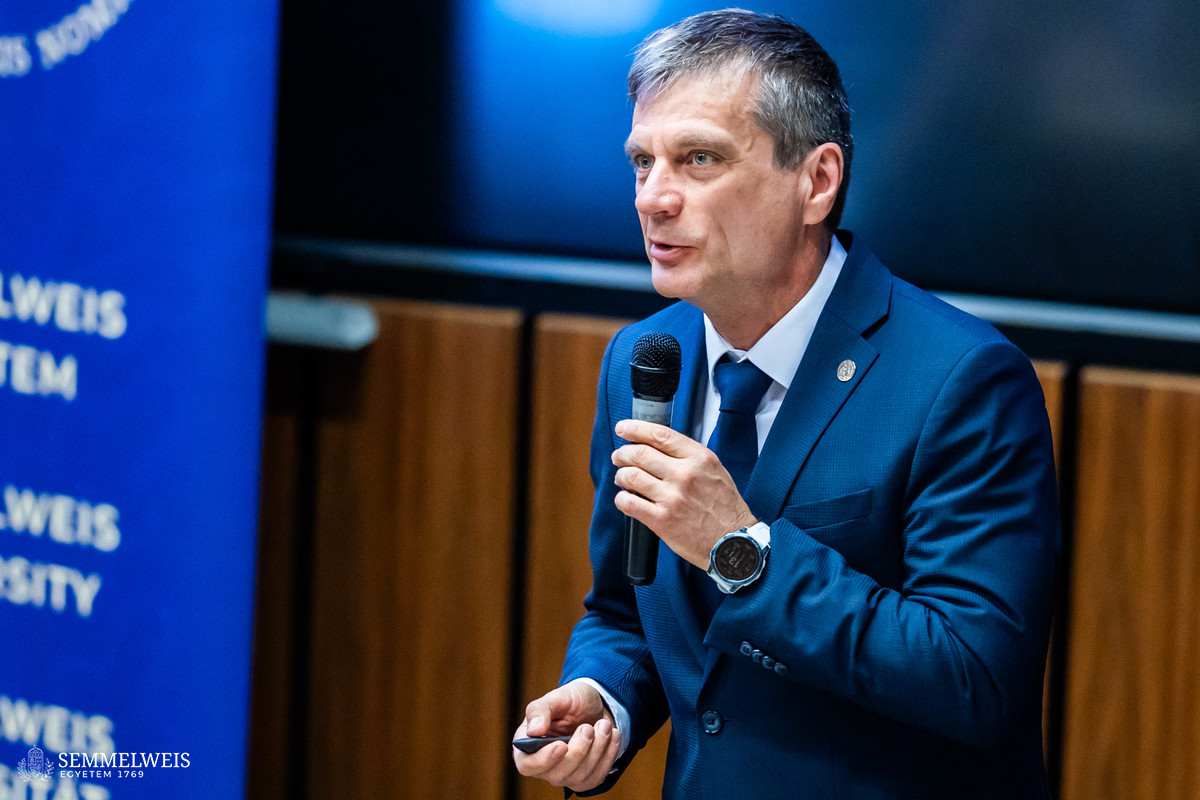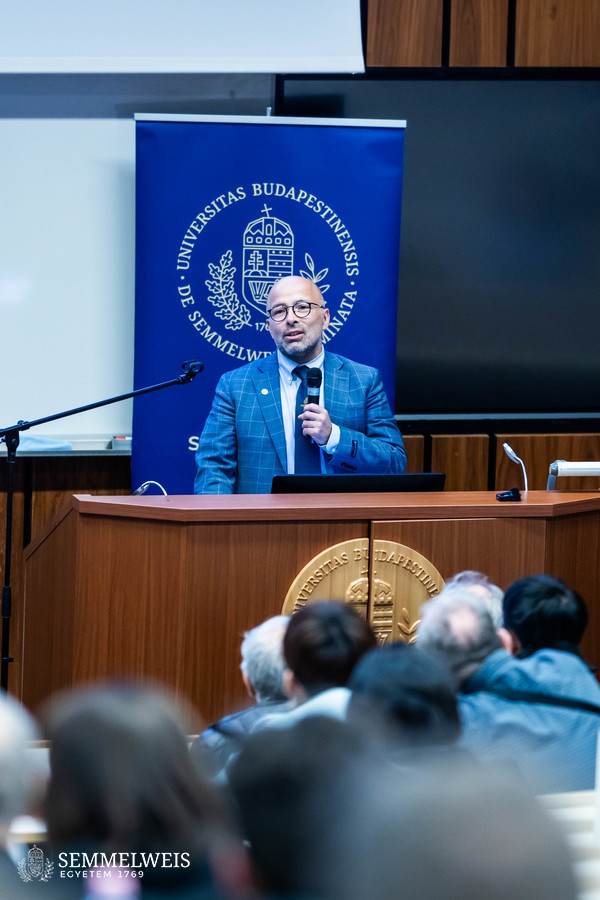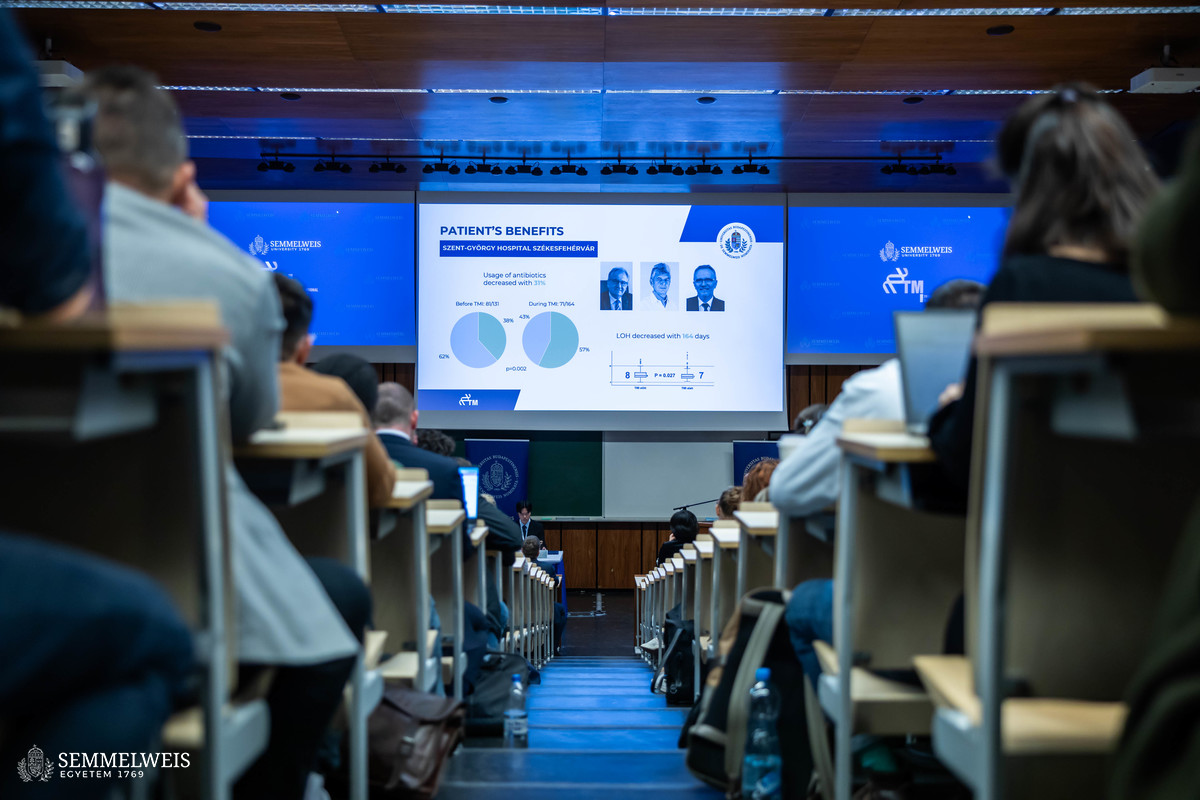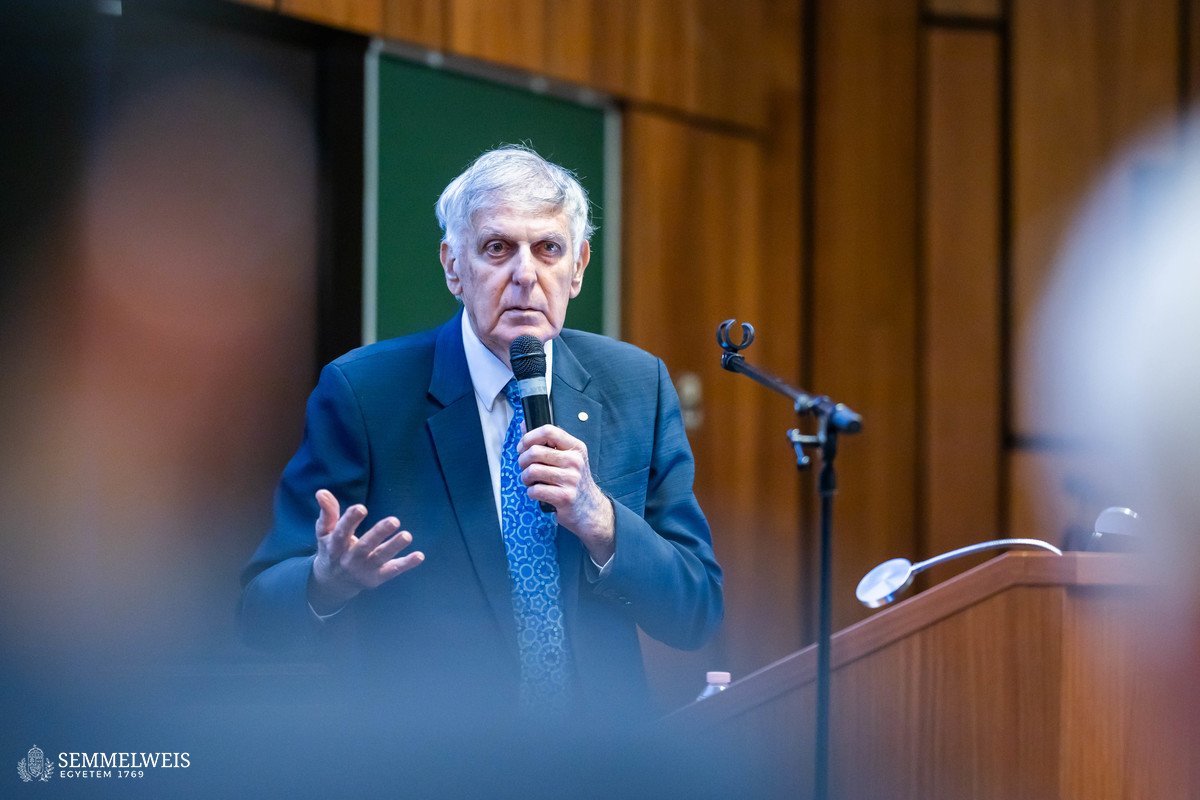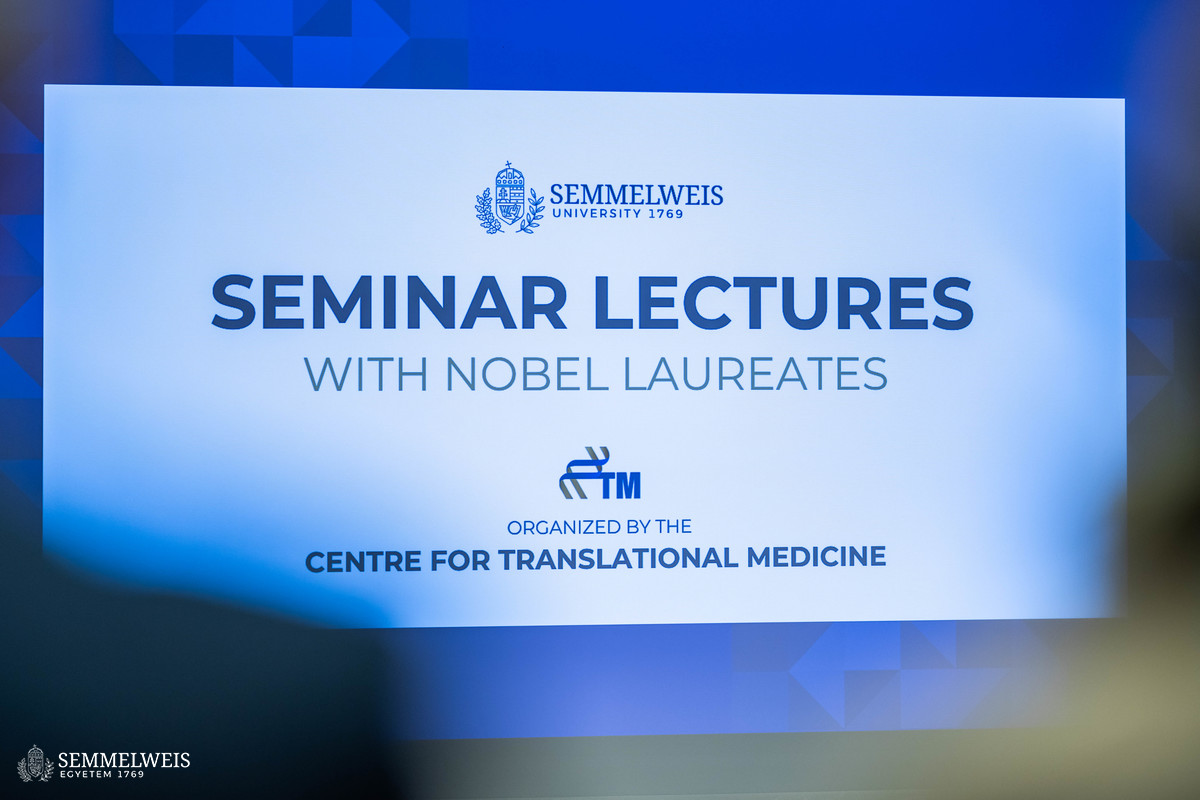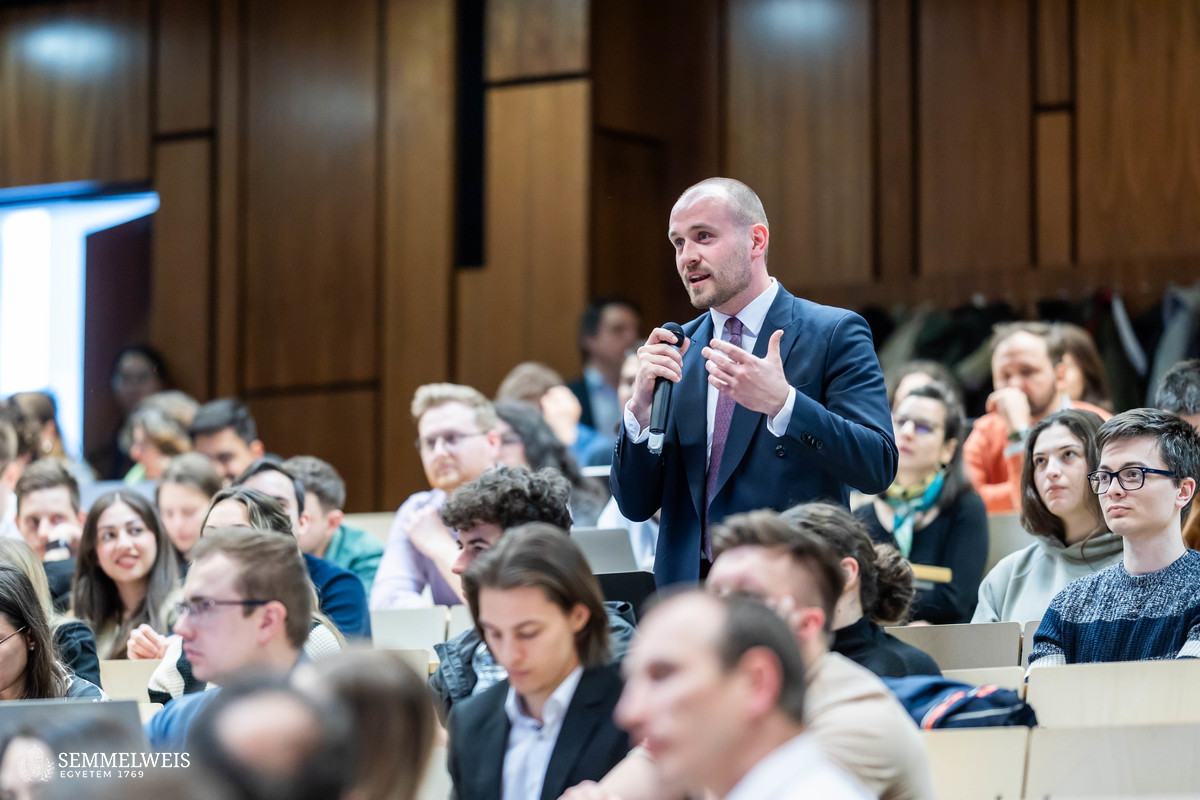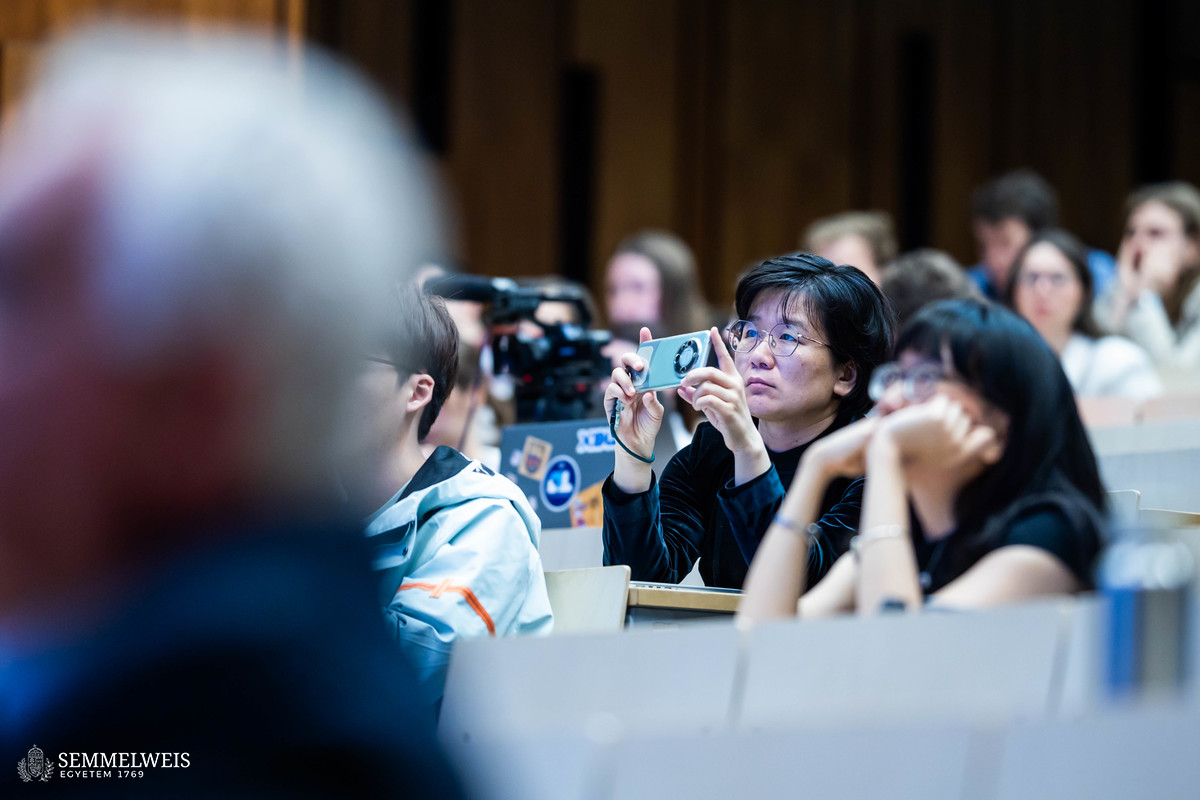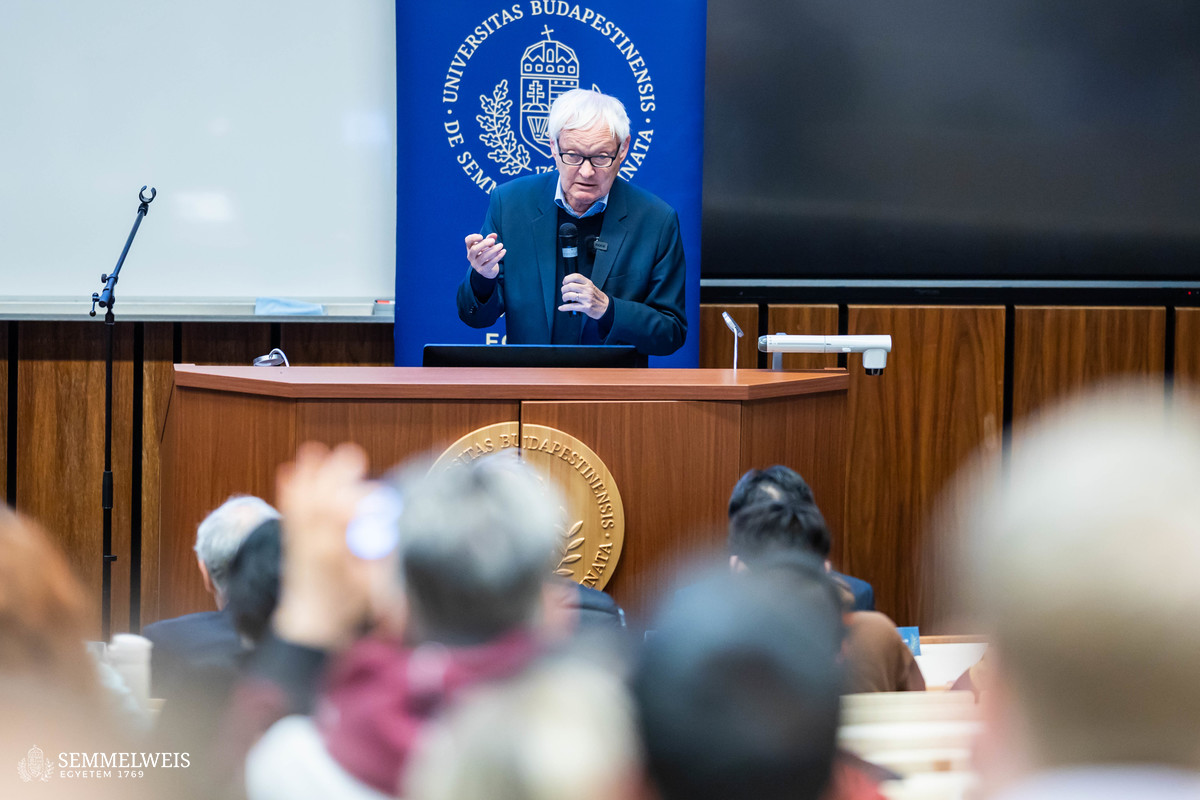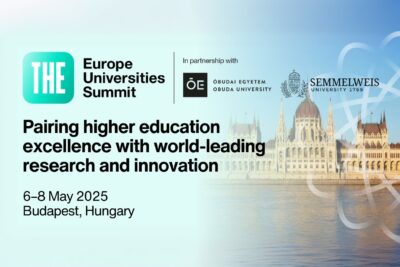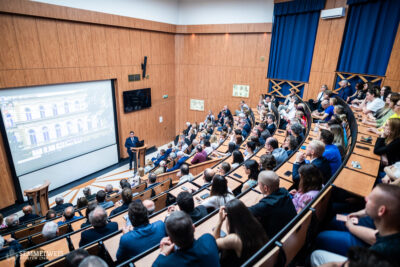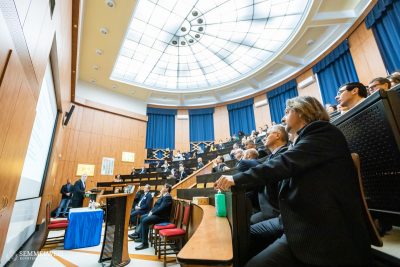During the opening ceremony, Dr. Péter Ferdinandy, Vice-Rector for Science and Innovations, presented Semmelweis University’s scientific activities and healthcare innovation ecosystem. Dr. Péter Hegyi, Director of the Center for Translational Medicine (TMK), presented the work of the center and stressed that the current series of lectures was part of an initiative to reverse the declining interest in science among secondary school students, as well as to enable future young scientists in Hungary to follow the path “from curiosity to career” and to put the scientific knowledge they acquire at the service of society.
Nobel Prize-winning speakers Dan Shechtman, Joachim Frank, and Tim Hunt talked about the details and significance of their research, the different paths that led to their discoveries, and the insights they gained along the way.
The scientific afternoon also featured renowned international experts such as David Weinberg, US gastroenterologist and Co-Editor-in-Chief of the journal Gastroenterology; and Dennis Lo, molecular biologist from Hong Kong and 2022 Lasker-DeBakey Award recipient, who both shared their experiences with the audience.
British biochemist Tim Hunt was awarded the 2001 Nobel Prize in Physiology or Medicine with his fellow researchers for discovering proteins that regulate the cell cycle, which provided fundamental insights into cell division and understanding the physiological processes. As he shared with our website, he realized in retrospect how his religious upbringing had influenced his discovery in a bizarre manner. He was studying sea urchin eggs at the time and was completely stuck, as all his hypotheses had failed. He had recently read the 1913 work Artificial parthenogenesis and fertilization by Jacques Loeb, in which Loeb succeeded in inducing the development of eggs by simple chemical treatments. “I wondered whether protein synthesis worked the same in eggs with proper versus artificial fertilization. As a child of devout Christian parents, I was interested in this kind of asexual reproduction, which allowed me to be able to do an experiment in molecular biology. The experiment proved to be pointless, but that’s when I discovered that one of the proteins disappeared in the process. And that was electrifying because it was at the time thought to be theoretically impossible. A few years before, I had heard a seminar about the changes that happened when cells were dividing. As luck would have it, I ran into the man who had given this seminar, and I told him about what I had seen that very morning, and he told me an electrifying fact that put this into context. In order for a cell to divide, you have to make a new protein. And in order to complete the division, that protein has to be destroyed – and I have just seen this protein go away. It was literally a eureka moment! And I was very very lucky. All this happened on July the 23rd,1982, but of course it took me another six years of research to figure out what was exactly going on,” the researcher recalled the historic days.
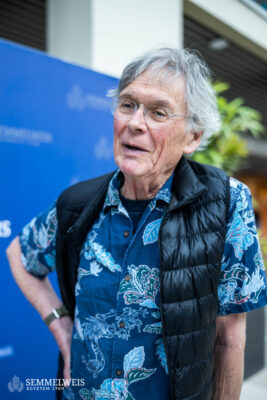 The British biochemist also considers it fortunate that there was not so much competition in the field at the time, with almost all researchers knowing each other. “We knew how little we knew, and we knew that there was a really important nugget of information to be discovered, and it was just a matter of digging a bit more to unearth it. And, of course, there were difficulties along the way, there always are, but you just have to keep going. If you get stuck in one road, then you see if there’s a side street that goes around it,” he noted. One of the most essential conclusions for him was that he was studying one thing and discovered something completely different. “It’s like when people stumble over a stone, they turn it over, and something crawls out they’ve never seen before. So, I always tell people, you have to keep your feet on the ground, but your eye on the horizon.” Although many people initially thought his theory was insane, he recalls that the decade of 1985-1995 was a wonderful period of his life, and it was a real privilege and pleasure to work with scientists of such caliber. “Back then, geneticists and biochemists hardly spoke to one another. They sort of despised one another. However, we came to understand the limits and strengths of our approaches, and we learned a lot from each other,” Tim Hunt shared his experiences.
The British biochemist also considers it fortunate that there was not so much competition in the field at the time, with almost all researchers knowing each other. “We knew how little we knew, and we knew that there was a really important nugget of information to be discovered, and it was just a matter of digging a bit more to unearth it. And, of course, there were difficulties along the way, there always are, but you just have to keep going. If you get stuck in one road, then you see if there’s a side street that goes around it,” he noted. One of the most essential conclusions for him was that he was studying one thing and discovered something completely different. “It’s like when people stumble over a stone, they turn it over, and something crawls out they’ve never seen before. So, I always tell people, you have to keep your feet on the ground, but your eye on the horizon.” Although many people initially thought his theory was insane, he recalls that the decade of 1985-1995 was a wonderful period of his life, and it was a real privilege and pleasure to work with scientists of such caliber. “Back then, geneticists and biochemists hardly spoke to one another. They sort of despised one another. However, we came to understand the limits and strengths of our approaches, and we learned a lot from each other,” Tim Hunt shared his experiences.
 Israeli researcher Dan Shechtman was awarded the Nobel Prize in Chemistry in 2011 for his discovery of quasicrystals, opening a new chapter in materials science. This field of science is aimed at understanding the relationship between the internal structure and the properties of materials and thus creating new materials or structures capable of delivering complex functions. In his view, science and technology can progress in two ways, one of them being predictable ‘evolution’ and the other being unpredictable ‘revolution’, a path that the Nobel laureates sitting in the room have also taken, as their research has revealed something unexpected that has taken science, and therefore progress, in a new direction. As he recalled, the day – and time of day – of his lecture at Semmelweis fell on the anniversary of his discovery of quasicrystals, which he prefers to call quasiperiodic crystals. He credits his grandfather as the greatest influence on his life, who introduced him to the world of science and taught him never to believe everything without reservation, but to doubt and question. He was also the one who gifted him his first magnifying glass, with which he looked at insects, plants, and rusty nails as he was walking around the neighborhood. He was oriented towards mechanical engineering thanks to his childhood read, Jules Verne’s The Mysterious Island, which he read from cover to cover 25 times, and wanted to grow up to be like the engineer protagonist who could solve everything.
Israeli researcher Dan Shechtman was awarded the Nobel Prize in Chemistry in 2011 for his discovery of quasicrystals, opening a new chapter in materials science. This field of science is aimed at understanding the relationship between the internal structure and the properties of materials and thus creating new materials or structures capable of delivering complex functions. In his view, science and technology can progress in two ways, one of them being predictable ‘evolution’ and the other being unpredictable ‘revolution’, a path that the Nobel laureates sitting in the room have also taken, as their research has revealed something unexpected that has taken science, and therefore progress, in a new direction. As he recalled, the day – and time of day – of his lecture at Semmelweis fell on the anniversary of his discovery of quasicrystals, which he prefers to call quasiperiodic crystals. He credits his grandfather as the greatest influence on his life, who introduced him to the world of science and taught him never to believe everything without reservation, but to doubt and question. He was also the one who gifted him his first magnifying glass, with which he looked at insects, plants, and rusty nails as he was walking around the neighborhood. He was oriented towards mechanical engineering thanks to his childhood read, Jules Verne’s The Mysterious Island, which he read from cover to cover 25 times, and wanted to grow up to be like the engineer protagonist who could solve everything.
The idea to research rapidly solidifying aluminum alloys came from a corridor conversation. Dan Shechtman then went on a sabbatical funded by DARPA, the research and development agency of the United States Department of Defense, to develop aluminum and transition metal alloys. “Sometimes, we scientists ‘bluff’ the system and do more experiments than promised. I did the same: I delivered what I promised, but I also went further and experimented with alloys that I knew from the beginning were useless for the assignment, but which promised to be fantastically interesting. On April 8, 1982, I discovered a tenfold rotational symmetry in the alloy I was testing. At first, I was telling myself that this could not be possible, as we only knew of two, three, four, and sixfold symmetries. I assumed it was a twin crystal of some kind, but by the end of the day, I was certain that it was something new. But it took time to find out exactly what it was,” he explained. Although he regards the Nobel Prize as a life-changing experience, he considers his family, his 12 grandchildren, four children, and one wife, to be the most important. A 2012 interview question inspired him to develop a pedagogical program that was implemented in 60 institutions in Haifa, where teachers with a degree in chemistry conduct real chemistry experiments with five to six-year-old children in a laboratory installed in the kindergarten. The project was also broadcast as a ten-episode series on national television.
I think that education is job number one for every country; the more scientists and engineers, the better. I believe that the fate of the country depends on this. – Dan Shechtman
The scientist stressed to our website that it was this idea that led him to organize a class on technological entrepreneurship at Technion with the attendance of 600 students weekly for about 30 years.
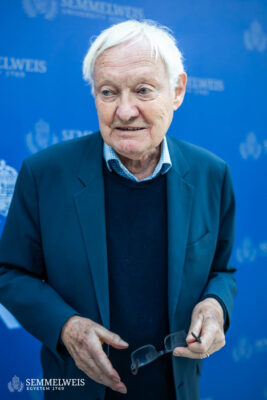 German-American biophysicist Joachim Frank won a shared Nobel Prize in Chemistry in 2017 for developing cryo-electron microscopy, which allows samples to be observed in their natural aqueous environment and produces high-resolution, three-dimensional structural images, revolutionizing life science research and drug development. His curiosity was already driving him as a child, so he piled up various chemicals, including hydrochloric acid and petroleum, under the veranda of their home. On one occasion, his venture culminated in an explosion, but luckily, he not only survived but managed to keep it a secret so he could continue his experiments. This quest for knowledge and observation has accompanied him throughout his career and has become an integral part of his life beyond the lab as he spends his free time photographing and writing. When asked about the motivation behind his discovery, he revealed that it was developed in juxtaposition to a fellow scientist’s hypothesis with which he disagreed. Although many people doubted him, he persisted and proved his theory to be true. Following the Nobel announcement, the professor was deeply touched by the congratulatory letter of an associate clinical professor, who thanked him for his scientific breakthrough on behalf of his grandchild born with cystic fibrosis and then treated with combination therapy. The technology later contributed to combatting infectious diseases such as malaria, tuberculosis, and even COVID-19, and may also help to fight further currently incurable diseases. The biophysicist advises young scientists to keep their peripheral vision open: “Don’t just follow a specific plan because you don’t know what opportunities come along.”
German-American biophysicist Joachim Frank won a shared Nobel Prize in Chemistry in 2017 for developing cryo-electron microscopy, which allows samples to be observed in their natural aqueous environment and produces high-resolution, three-dimensional structural images, revolutionizing life science research and drug development. His curiosity was already driving him as a child, so he piled up various chemicals, including hydrochloric acid and petroleum, under the veranda of their home. On one occasion, his venture culminated in an explosion, but luckily, he not only survived but managed to keep it a secret so he could continue his experiments. This quest for knowledge and observation has accompanied him throughout his career and has become an integral part of his life beyond the lab as he spends his free time photographing and writing. When asked about the motivation behind his discovery, he revealed that it was developed in juxtaposition to a fellow scientist’s hypothesis with which he disagreed. Although many people doubted him, he persisted and proved his theory to be true. Following the Nobel announcement, the professor was deeply touched by the congratulatory letter of an associate clinical professor, who thanked him for his scientific breakthrough on behalf of his grandchild born with cystic fibrosis and then treated with combination therapy. The technology later contributed to combatting infectious diseases such as malaria, tuberculosis, and even COVID-19, and may also help to fight further currently incurable diseases. The biophysicist advises young scientists to keep their peripheral vision open: “Don’t just follow a specific plan because you don’t know what opportunities come along.”
Judit Szabados-Dőtsch
Photos by Bálint Barta – Semmelweis University

